Economics Assignment 2: Price Floors, Costs, and Competitive Markets
VerifiedAdded on 2023/05/28
|8
|1480
|458
Homework Assignment
AI Summary
This economics assignment delves into several key microeconomic concepts. The first section examines the impact of price floors on market equilibrium, illustrating how they create surpluses and potentially reduce overall welfare by affecting consumer and producer surplus and allocative efficiency. The second section analyzes cost and revenue, focusing on marginal cost and marginal revenue to explain how firms maximize profits. The assignment uses graphical representations to demonstrate the profit-maximizing point where marginal cost equals marginal revenue. The final section explores perfectly competitive markets, highlighting their characteristics, including free entry and exit, and emphasizing how they achieve allocative efficiency in the long run. The analysis underscores the importance of these concepts in understanding market dynamics and firm decision-making.
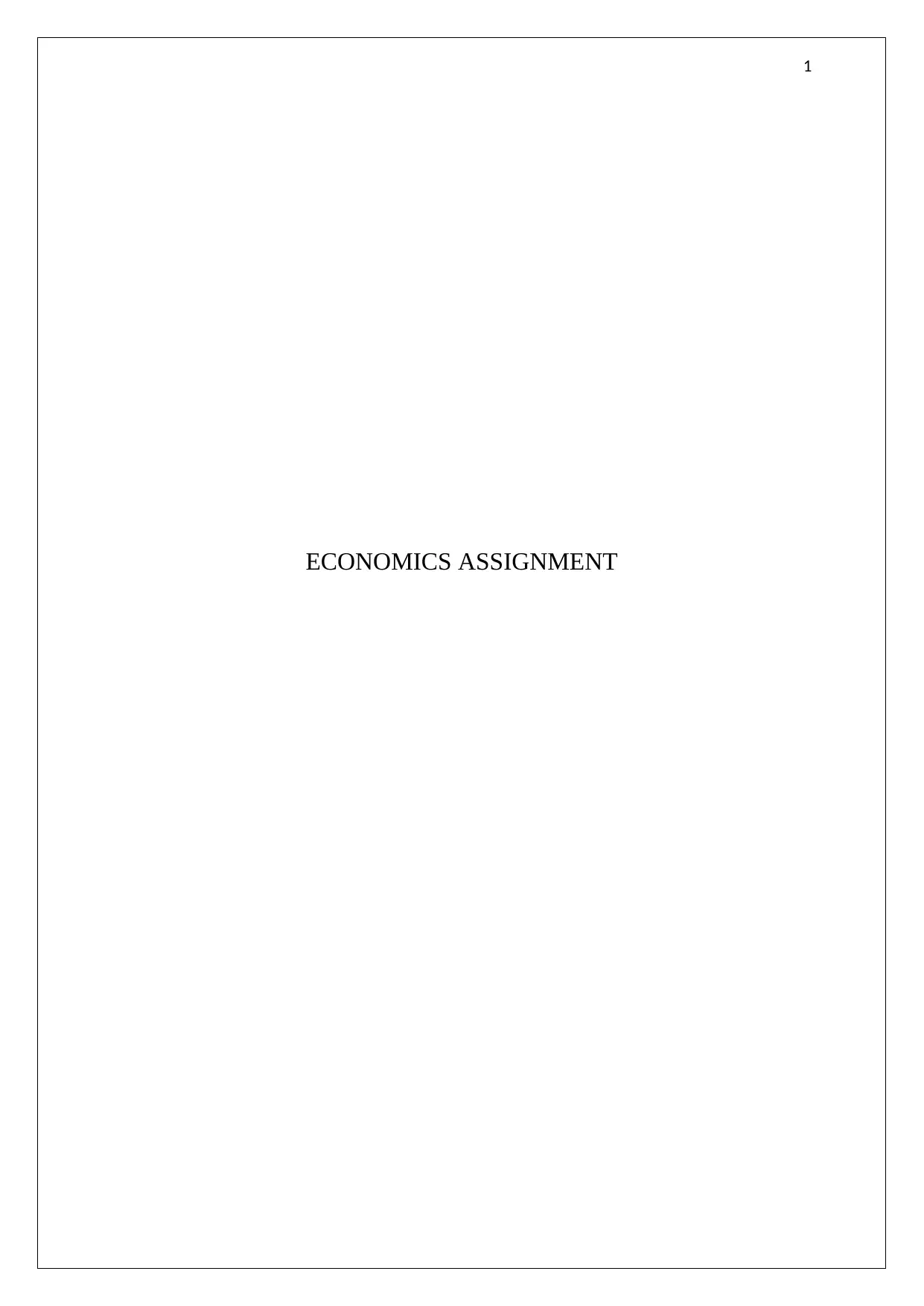
1
ECONOMICS ASSIGNMENT
ECONOMICS ASSIGNMENT
Paraphrase This Document
Need a fresh take? Get an instant paraphrase of this document with our AI Paraphraser
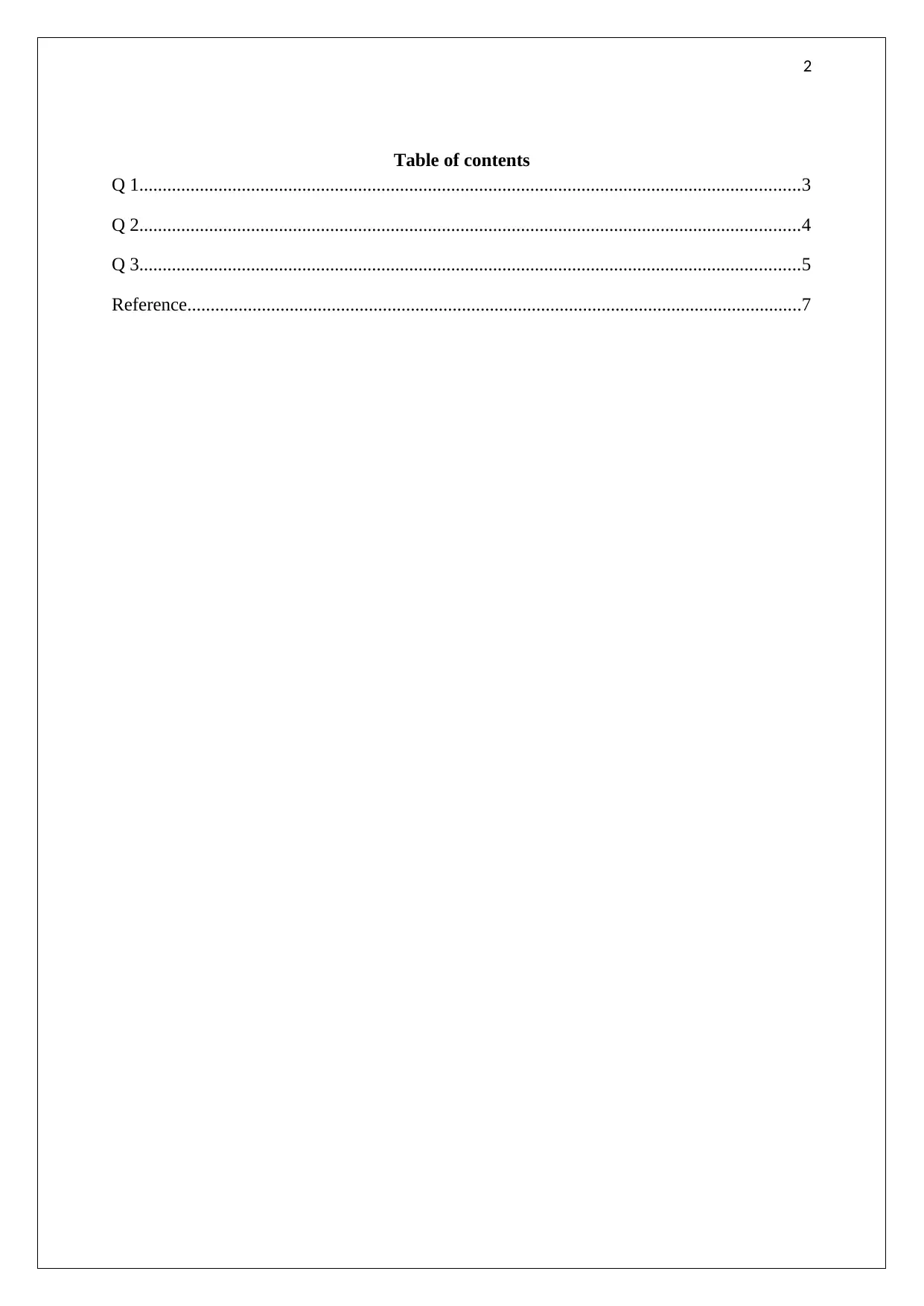
2
Table of contents
Q 1..............................................................................................................................................3
Q 2..............................................................................................................................................4
Q 3..............................................................................................................................................5
Reference....................................................................................................................................7
Table of contents
Q 1..............................................................................................................................................3
Q 2..............................................................................................................................................4
Q 3..............................................................................................................................................5
Reference....................................................................................................................................7
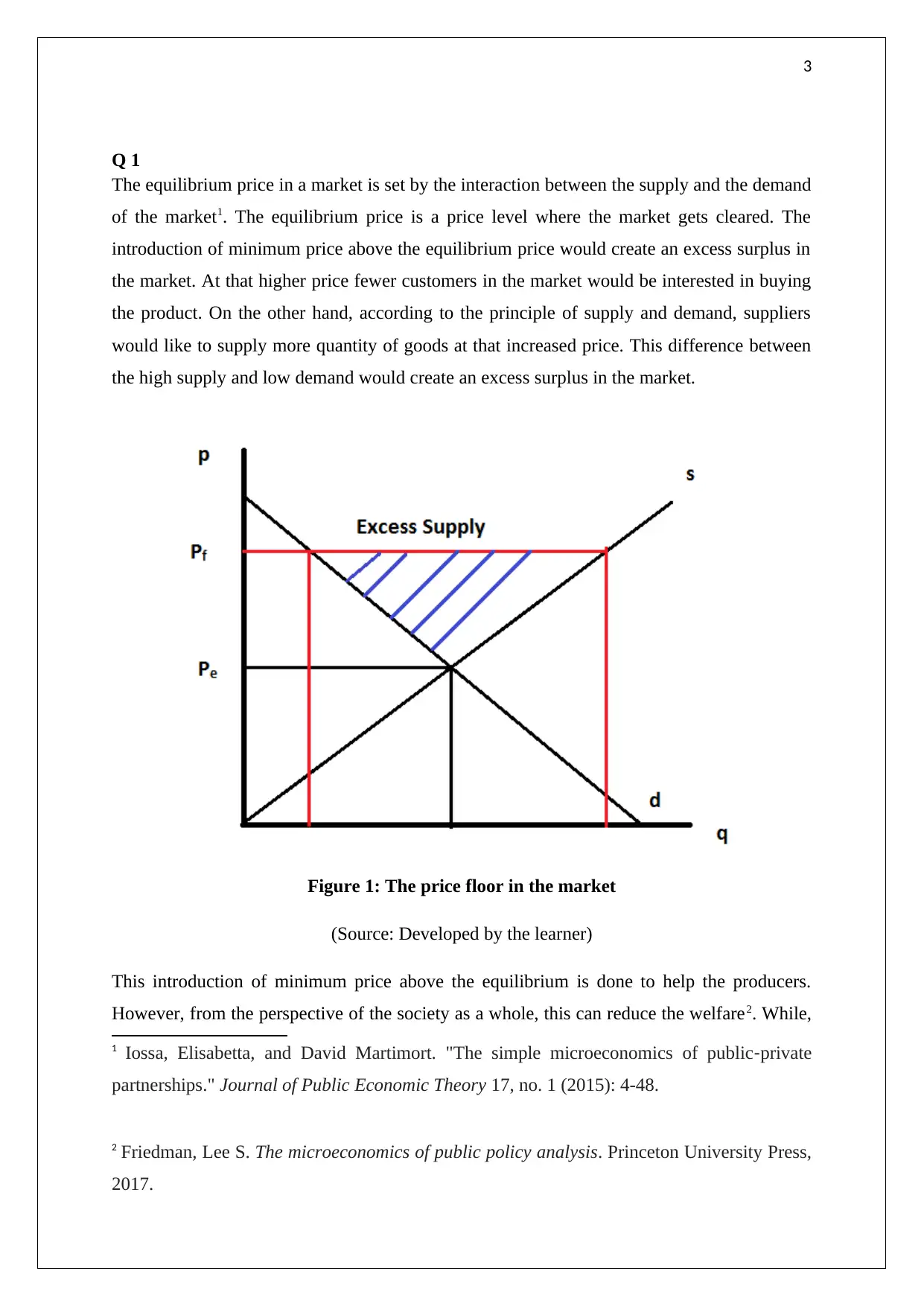
3
Q 1
The equilibrium price in a market is set by the interaction between the supply and the demand
of the market1. The equilibrium price is a price level where the market gets cleared. The
introduction of minimum price above the equilibrium price would create an excess surplus in
the market. At that higher price fewer customers in the market would be interested in buying
the product. On the other hand, according to the principle of supply and demand, suppliers
would like to supply more quantity of goods at that increased price. This difference between
the high supply and low demand would create an excess surplus in the market.
Figure 1: The price floor in the market
(Source: Developed by the learner)
This introduction of minimum price above the equilibrium is done to help the producers.
However, from the perspective of the society as a whole, this can reduce the welfare2. While,
1 Iossa, Elisabetta, and David Martimort. "The simple microeconomics of public‐private
partnerships." Journal of Public Economic Theory 17, no. 1 (2015): 4-48.
2 Friedman, Lee S. The microeconomics of public policy analysis. Princeton University Press,
2017.
Q 1
The equilibrium price in a market is set by the interaction between the supply and the demand
of the market1. The equilibrium price is a price level where the market gets cleared. The
introduction of minimum price above the equilibrium price would create an excess surplus in
the market. At that higher price fewer customers in the market would be interested in buying
the product. On the other hand, according to the principle of supply and demand, suppliers
would like to supply more quantity of goods at that increased price. This difference between
the high supply and low demand would create an excess surplus in the market.
Figure 1: The price floor in the market
(Source: Developed by the learner)
This introduction of minimum price above the equilibrium is done to help the producers.
However, from the perspective of the society as a whole, this can reduce the welfare2. While,
1 Iossa, Elisabetta, and David Martimort. "The simple microeconomics of public‐private
partnerships." Journal of Public Economic Theory 17, no. 1 (2015): 4-48.
2 Friedman, Lee S. The microeconomics of public policy analysis. Princeton University Press,
2017.
⊘ This is a preview!⊘
Do you want full access?
Subscribe today to unlock all pages.

Trusted by 1+ million students worldwide
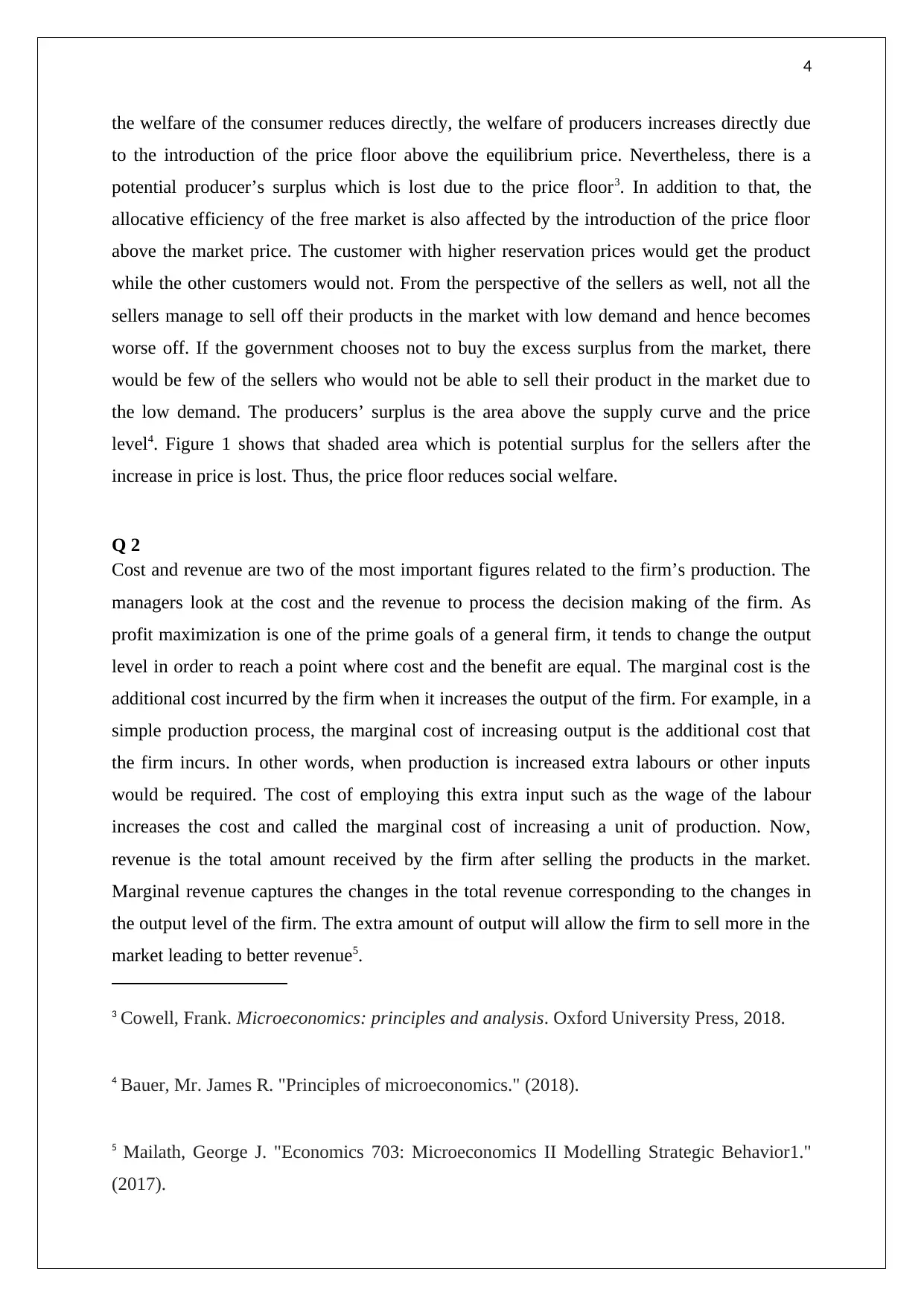
4
the welfare of the consumer reduces directly, the welfare of producers increases directly due
to the introduction of the price floor above the equilibrium price. Nevertheless, there is a
potential producer’s surplus which is lost due to the price floor3. In addition to that, the
allocative efficiency of the free market is also affected by the introduction of the price floor
above the market price. The customer with higher reservation prices would get the product
while the other customers would not. From the perspective of the sellers as well, not all the
sellers manage to sell off their products in the market with low demand and hence becomes
worse off. If the government chooses not to buy the excess surplus from the market, there
would be few of the sellers who would not be able to sell their product in the market due to
the low demand. The producers’ surplus is the area above the supply curve and the price
level4. Figure 1 shows that shaded area which is potential surplus for the sellers after the
increase in price is lost. Thus, the price floor reduces social welfare.
Q 2
Cost and revenue are two of the most important figures related to the firm’s production. The
managers look at the cost and the revenue to process the decision making of the firm. As
profit maximization is one of the prime goals of a general firm, it tends to change the output
level in order to reach a point where cost and the benefit are equal. The marginal cost is the
additional cost incurred by the firm when it increases the output of the firm. For example, in a
simple production process, the marginal cost of increasing output is the additional cost that
the firm incurs. In other words, when production is increased extra labours or other inputs
would be required. The cost of employing this extra input such as the wage of the labour
increases the cost and called the marginal cost of increasing a unit of production. Now,
revenue is the total amount received by the firm after selling the products in the market.
Marginal revenue captures the changes in the total revenue corresponding to the changes in
the output level of the firm. The extra amount of output will allow the firm to sell more in the
market leading to better revenue5.
3 Cowell, Frank. Microeconomics: principles and analysis. Oxford University Press, 2018.
4 Bauer, Mr. James R. "Principles of microeconomics." (2018).
5 Mailath, George J. "Economics 703: Microeconomics II Modelling Strategic Behavior1."
(2017).
the welfare of the consumer reduces directly, the welfare of producers increases directly due
to the introduction of the price floor above the equilibrium price. Nevertheless, there is a
potential producer’s surplus which is lost due to the price floor3. In addition to that, the
allocative efficiency of the free market is also affected by the introduction of the price floor
above the market price. The customer with higher reservation prices would get the product
while the other customers would not. From the perspective of the sellers as well, not all the
sellers manage to sell off their products in the market with low demand and hence becomes
worse off. If the government chooses not to buy the excess surplus from the market, there
would be few of the sellers who would not be able to sell their product in the market due to
the low demand. The producers’ surplus is the area above the supply curve and the price
level4. Figure 1 shows that shaded area which is potential surplus for the sellers after the
increase in price is lost. Thus, the price floor reduces social welfare.
Q 2
Cost and revenue are two of the most important figures related to the firm’s production. The
managers look at the cost and the revenue to process the decision making of the firm. As
profit maximization is one of the prime goals of a general firm, it tends to change the output
level in order to reach a point where cost and the benefit are equal. The marginal cost is the
additional cost incurred by the firm when it increases the output of the firm. For example, in a
simple production process, the marginal cost of increasing output is the additional cost that
the firm incurs. In other words, when production is increased extra labours or other inputs
would be required. The cost of employing this extra input such as the wage of the labour
increases the cost and called the marginal cost of increasing a unit of production. Now,
revenue is the total amount received by the firm after selling the products in the market.
Marginal revenue captures the changes in the total revenue corresponding to the changes in
the output level of the firm. The extra amount of output will allow the firm to sell more in the
market leading to better revenue5.
3 Cowell, Frank. Microeconomics: principles and analysis. Oxford University Press, 2018.
4 Bauer, Mr. James R. "Principles of microeconomics." (2018).
5 Mailath, George J. "Economics 703: Microeconomics II Modelling Strategic Behavior1."
(2017).
Paraphrase This Document
Need a fresh take? Get an instant paraphrase of this document with our AI Paraphraser
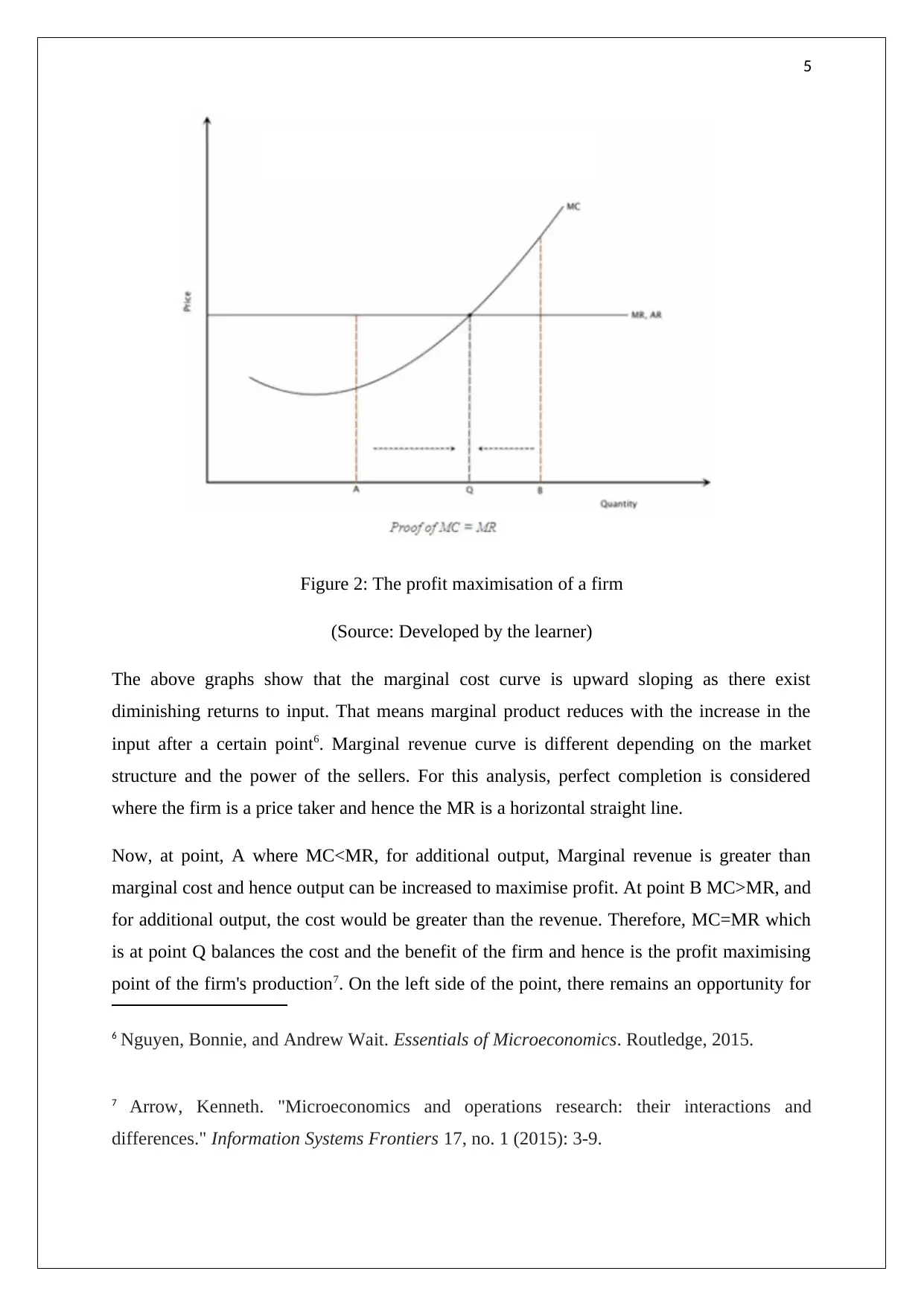
5
Figure 2: The profit maximisation of a firm
(Source: Developed by the learner)
The above graphs show that the marginal cost curve is upward sloping as there exist
diminishing returns to input. That means marginal product reduces with the increase in the
input after a certain point6. Marginal revenue curve is different depending on the market
structure and the power of the sellers. For this analysis, perfect completion is considered
where the firm is a price taker and hence the MR is a horizontal straight line.
Now, at point, A where MC<MR, for additional output, Marginal revenue is greater than
marginal cost and hence output can be increased to maximise profit. At point B MC>MR, and
for additional output, the cost would be greater than the revenue. Therefore, MC=MR which
is at point Q balances the cost and the benefit of the firm and hence is the profit maximising
point of the firm's production7. On the left side of the point, there remains an opportunity for
6 Nguyen, Bonnie, and Andrew Wait. Essentials of Microeconomics. Routledge, 2015.
7 Arrow, Kenneth. "Microeconomics and operations research: their interactions and
differences." Information Systems Frontiers 17, no. 1 (2015): 3-9.
Figure 2: The profit maximisation of a firm
(Source: Developed by the learner)
The above graphs show that the marginal cost curve is upward sloping as there exist
diminishing returns to input. That means marginal product reduces with the increase in the
input after a certain point6. Marginal revenue curve is different depending on the market
structure and the power of the sellers. For this analysis, perfect completion is considered
where the firm is a price taker and hence the MR is a horizontal straight line.
Now, at point, A where MC<MR, for additional output, Marginal revenue is greater than
marginal cost and hence output can be increased to maximise profit. At point B MC>MR, and
for additional output, the cost would be greater than the revenue. Therefore, MC=MR which
is at point Q balances the cost and the benefit of the firm and hence is the profit maximising
point of the firm's production7. On the left side of the point, there remains an opportunity for
6 Nguyen, Bonnie, and Andrew Wait. Essentials of Microeconomics. Routledge, 2015.
7 Arrow, Kenneth. "Microeconomics and operations research: their interactions and
differences." Information Systems Frontiers 17, no. 1 (2015): 3-9.
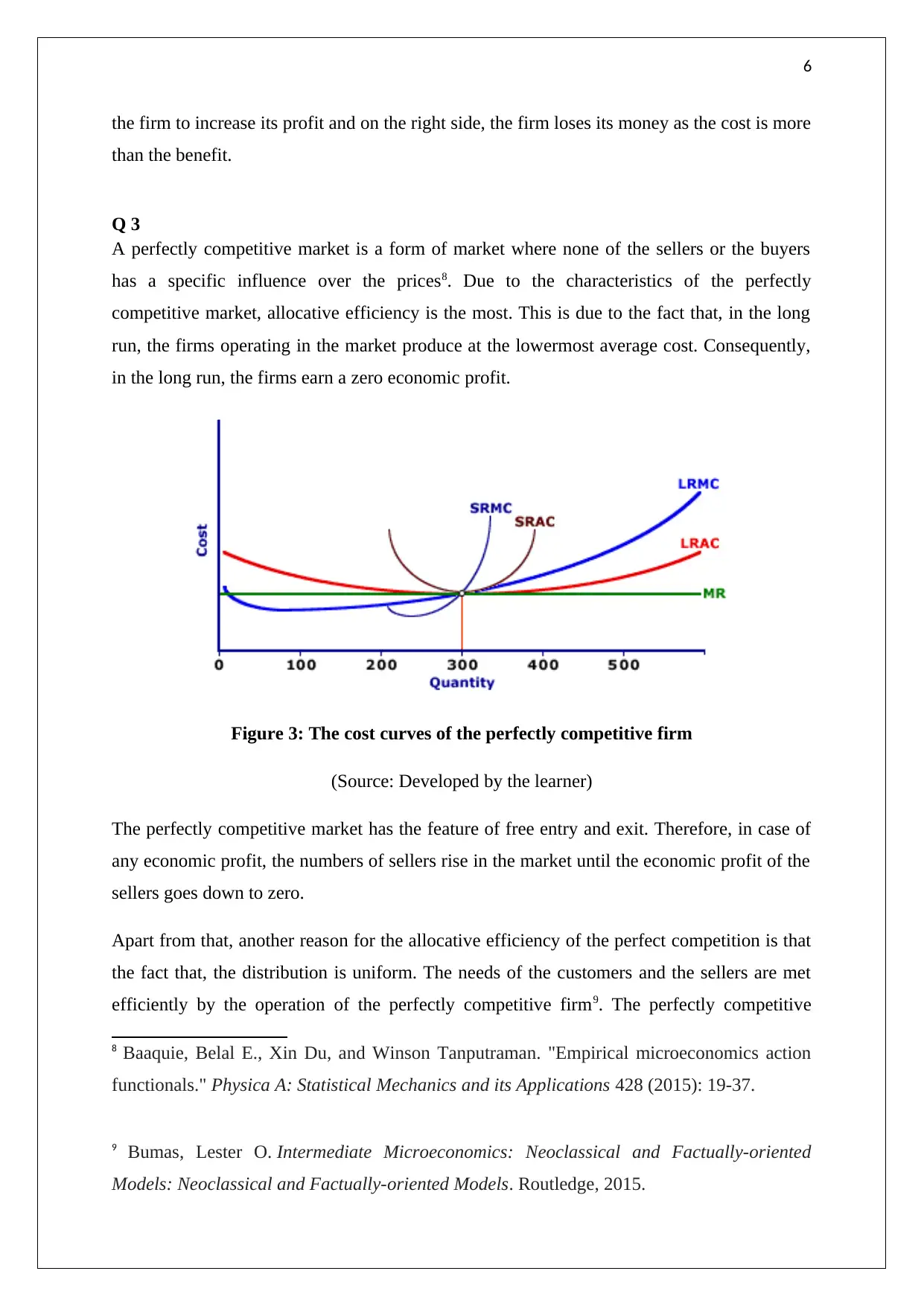
6
the firm to increase its profit and on the right side, the firm loses its money as the cost is more
than the benefit.
Q 3
A perfectly competitive market is a form of market where none of the sellers or the buyers
has a specific influence over the prices8. Due to the characteristics of the perfectly
competitive market, allocative efficiency is the most. This is due to the fact that, in the long
run, the firms operating in the market produce at the lowermost average cost. Consequently,
in the long run, the firms earn a zero economic profit.
Figure 3: The cost curves of the perfectly competitive firm
(Source: Developed by the learner)
The perfectly competitive market has the feature of free entry and exit. Therefore, in case of
any economic profit, the numbers of sellers rise in the market until the economic profit of the
sellers goes down to zero.
Apart from that, another reason for the allocative efficiency of the perfect competition is that
the fact that, the distribution is uniform. The needs of the customers and the sellers are met
efficiently by the operation of the perfectly competitive firm9. The perfectly competitive
8 Baaquie, Belal E., Xin Du, and Winson Tanputraman. "Empirical microeconomics action
functionals." Physica A: Statistical Mechanics and its Applications 428 (2015): 19-37.
9 Bumas, Lester O. Intermediate Microeconomics: Neoclassical and Factually-oriented
Models: Neoclassical and Factually-oriented Models. Routledge, 2015.
the firm to increase its profit and on the right side, the firm loses its money as the cost is more
than the benefit.
Q 3
A perfectly competitive market is a form of market where none of the sellers or the buyers
has a specific influence over the prices8. Due to the characteristics of the perfectly
competitive market, allocative efficiency is the most. This is due to the fact that, in the long
run, the firms operating in the market produce at the lowermost average cost. Consequently,
in the long run, the firms earn a zero economic profit.
Figure 3: The cost curves of the perfectly competitive firm
(Source: Developed by the learner)
The perfectly competitive market has the feature of free entry and exit. Therefore, in case of
any economic profit, the numbers of sellers rise in the market until the economic profit of the
sellers goes down to zero.
Apart from that, another reason for the allocative efficiency of the perfect competition is that
the fact that, the distribution is uniform. The needs of the customers and the sellers are met
efficiently by the operation of the perfectly competitive firm9. The perfectly competitive
8 Baaquie, Belal E., Xin Du, and Winson Tanputraman. "Empirical microeconomics action
functionals." Physica A: Statistical Mechanics and its Applications 428 (2015): 19-37.
9 Bumas, Lester O. Intermediate Microeconomics: Neoclassical and Factually-oriented
Models: Neoclassical and Factually-oriented Models. Routledge, 2015.
⊘ This is a preview!⊘
Do you want full access?
Subscribe today to unlock all pages.

Trusted by 1+ million students worldwide
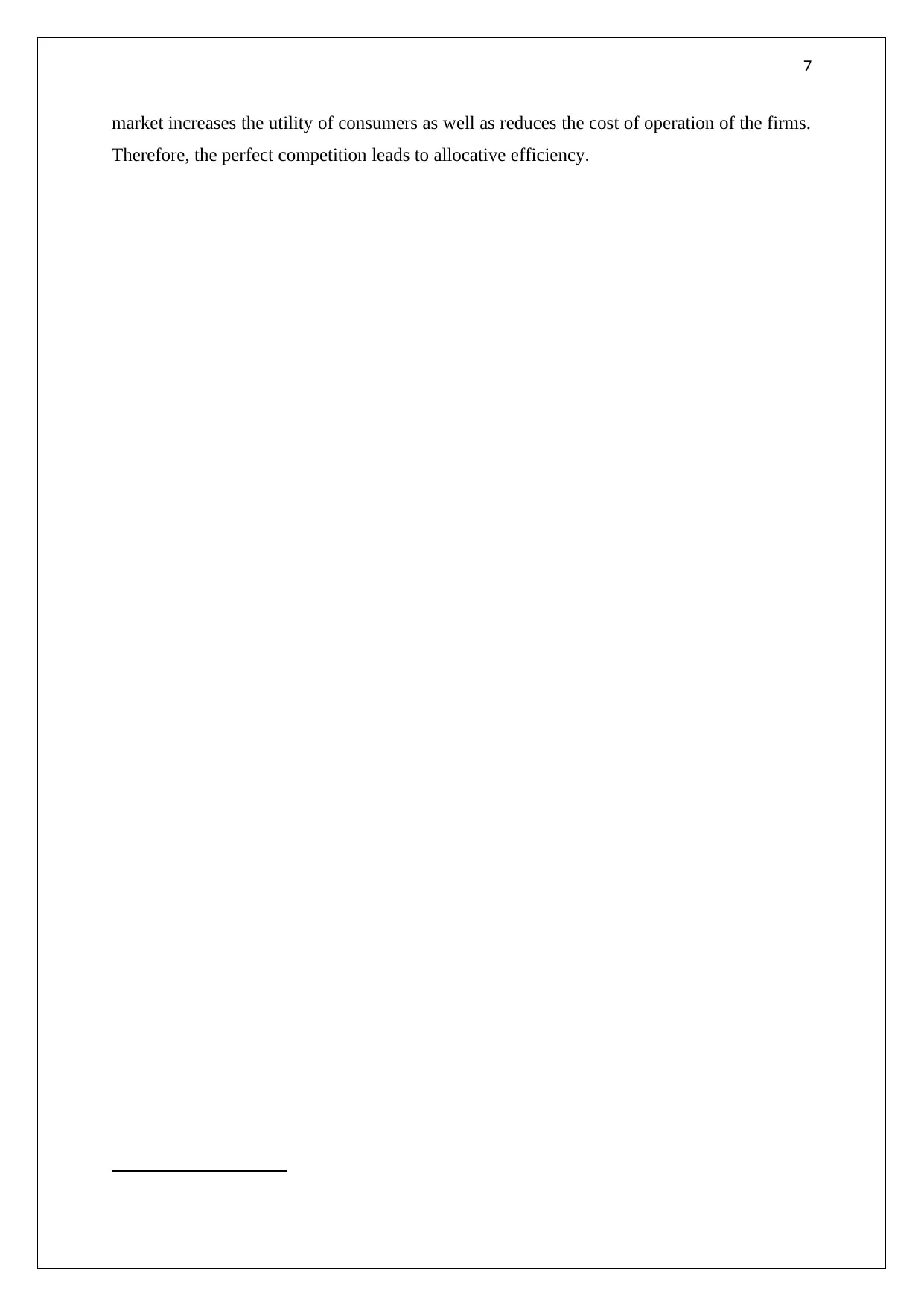
7
market increases the utility of consumers as well as reduces the cost of operation of the firms.
Therefore, the perfect competition leads to allocative efficiency.
market increases the utility of consumers as well as reduces the cost of operation of the firms.
Therefore, the perfect competition leads to allocative efficiency.
Paraphrase This Document
Need a fresh take? Get an instant paraphrase of this document with our AI Paraphraser
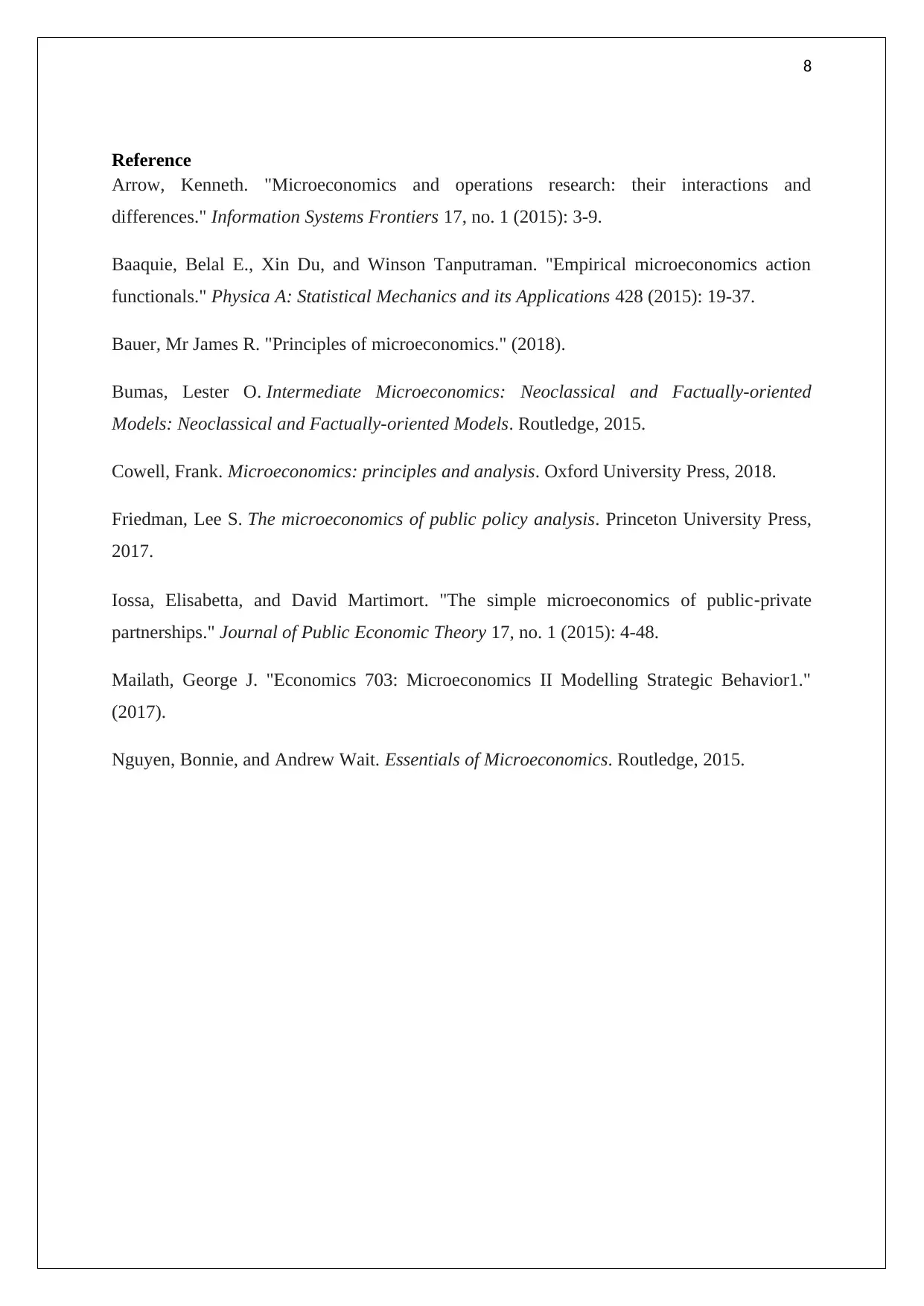
8
Reference
Arrow, Kenneth. "Microeconomics and operations research: their interactions and
differences." Information Systems Frontiers 17, no. 1 (2015): 3-9.
Baaquie, Belal E., Xin Du, and Winson Tanputraman. "Empirical microeconomics action
functionals." Physica A: Statistical Mechanics and its Applications 428 (2015): 19-37.
Bauer, Mr James R. "Principles of microeconomics." (2018).
Bumas, Lester O. Intermediate Microeconomics: Neoclassical and Factually-oriented
Models: Neoclassical and Factually-oriented Models. Routledge, 2015.
Cowell, Frank. Microeconomics: principles and analysis. Oxford University Press, 2018.
Friedman, Lee S. The microeconomics of public policy analysis. Princeton University Press,
2017.
Iossa, Elisabetta, and David Martimort. "The simple microeconomics of public‐private
partnerships." Journal of Public Economic Theory 17, no. 1 (2015): 4-48.
Mailath, George J. "Economics 703: Microeconomics II Modelling Strategic Behavior1."
(2017).
Nguyen, Bonnie, and Andrew Wait. Essentials of Microeconomics. Routledge, 2015.
Reference
Arrow, Kenneth. "Microeconomics and operations research: their interactions and
differences." Information Systems Frontiers 17, no. 1 (2015): 3-9.
Baaquie, Belal E., Xin Du, and Winson Tanputraman. "Empirical microeconomics action
functionals." Physica A: Statistical Mechanics and its Applications 428 (2015): 19-37.
Bauer, Mr James R. "Principles of microeconomics." (2018).
Bumas, Lester O. Intermediate Microeconomics: Neoclassical and Factually-oriented
Models: Neoclassical and Factually-oriented Models. Routledge, 2015.
Cowell, Frank. Microeconomics: principles and analysis. Oxford University Press, 2018.
Friedman, Lee S. The microeconomics of public policy analysis. Princeton University Press,
2017.
Iossa, Elisabetta, and David Martimort. "The simple microeconomics of public‐private
partnerships." Journal of Public Economic Theory 17, no. 1 (2015): 4-48.
Mailath, George J. "Economics 703: Microeconomics II Modelling Strategic Behavior1."
(2017).
Nguyen, Bonnie, and Andrew Wait. Essentials of Microeconomics. Routledge, 2015.
1 out of 8
Related Documents
Your All-in-One AI-Powered Toolkit for Academic Success.
+13062052269
info@desklib.com
Available 24*7 on WhatsApp / Email
![[object Object]](/_next/static/media/star-bottom.7253800d.svg)
Unlock your academic potential
Copyright © 2020–2025 A2Z Services. All Rights Reserved. Developed and managed by ZUCOL.





